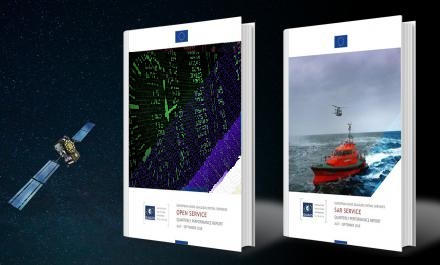Galileo OS and SAR Service Performance Reports for the second quarter of 2020 (covering April, May and June) have just been published on the European GNSS Service Centre (GSC) web portal.

The Galileo Open Service (OS) and Search and Rescue (SAR) quarterly performance reports provide the latest information on the Galileo OS and SAR/Galileo measured performance statistics with respect to their Minimum Performance Levels (MPLs) (as declared in its respective Galileo Service Definition Documents: OS-SDD and SAR-SDD).
Quarterly reports provide information to users on several parameters including:
- For Galileo OS: Ranging Performance, Galileo to GPS Time Offset (GGTO) determination performance, Galileo Positioning Performance, and the Timely Publication of NAGUs.
- For SAR/Galileo Enhanced Services: Availability of Forward Link Service (FLS) and Return Link Service (RLS), performance of location probability and accuracy, and RLS service latency.
Learn More: How is Galileo Performance Assessed?
Highlights from Q2-2020 Public Performance Reports:
As in previous periods, Galileo measured OS and SAR Service performance figures comfortably exceed their MPL thresholds, specified in the OS-SDD and SAR-SDD (except for the SAR transponder availability for GSAT-0103 during April, May and June).
Among the main highlights of the Q2-2020 performance reports:
Open Service:
- Galileo Open Service Ranging Performance: This is measured based on the Availability of the Galileo Single Frequency (SF)/Dual Frequency (DF) Ranging Service [between 96.45% (Signal in Space (SIS) E1, E5b and Dual Frequency combination E1-E5b, April) and 96.77% (SIS E5a and Dual Frequency combination E1-E5a, June)], Per-slot Availability of Healthy Signal in Space for each Galileo operational satellite [low values were observed for GSAT-0103 (81.18% in April and with F/NAV and I/NAV SIS availability of respectively 92.22% and 91.25% during June), GSAT-0210 (with F/NAV SIS availability of 93.61% in April) and GSAT-0203 (with F/NAV and I/NAV SIS availability of respectively 92.87% and 92.84% during May and with I/NAV SIS availability of 93.67% during June)] and the Galileo Signal in Space Ranging Accuracy [for individual space vehicles: worst case value of 0.45 [m] for DF in April and May and 0.75 [m] for SF in May; best case values of 0.14 [m] for DF in June and 0.19 [m] for SF in June].
- Galileo Universal Time Coordinate (UTC) and GST-GPS Time Offset (GGTO) Dissemination and Determination Performance: The Galileo UTC Determination Service Availability reached a monthly value of 100% during the entire quarter, exceeding the MPL target of 87%. Moreover, the GGTO Determination Availability exceeds the MPL target of 80% over the reported months, reaching 97.39% in April and 97.65% in May and June.
- Galileo Positioning Performance: This is measured based on the Availability of the Galileo Position Dilution of Precision and the Positioning Service, and the Galileo measured Positioning Performance.
- Timely Publication of NAGUs (Notice Advisory to Galileo Users): The timeliness requirements for NAGU publication were met both for Planned and Unplanned events (NAGUs related to planned events need to be published at least 24 hours before the event starts, and those related to unplanned events with a delay of up to 72 hours from the detection of the unplanned event). A total number of 6 NAGUs have been published on the GSC web portal in the reported period. If you wish to receive NAGUs automatically, please register to the GSC web portal.
Enhanced SAR/Galileo Service:
-
Availability of SAR/Galileo:
- Forward Link Service: 99.5% for the reported period (above defined MPLs of 99%).
- Medium Earth Orbit Local User Terminal (MEOLUT) facilities in “Nominal” and “Nominal + Degraded” modes: remain at excellent levels, always above the MPL targets of 95% in “Nominal” and 97.5% in “Nominal + Degraded” modes.
- Return Link Service: 100% all over the period (MPL set to 95%).
- SAR Transponders: achieved excellent levels of performance reaching monthly satellite transponder availability of 100% for almost all space vehicles (except for GSAT-0103 in April, May and June).
-
Performance of:
- Detection Service: monthly values of a valid message detection probability after a single transmitted burst over 99.8%, where the MPL target is 99%.
- Location Probability: excellent values were achieved, with monthly values higher than 99.1% for a single burst, where the MPL target is 90%, and 99.8% after 12 transmitted bursts (multi-burst), where the MPL target is 98%.
- Location Accuracy: surpassed the targets with monthly values higher than 99.2% for a single burst and 99.6% for multi-burst transmissions with accuracy better than 5 km, while the MPLs are 90% and 95% respectively.
-
Return Link Service:
- Delivery Latency within 15 min: 99.97% on average over the reported period for an MPL set to 99%.
- Reception Probability: 99.99% on average over the reported period for an MPL set to 99%.
For the most up-to-date information on the Galileo system and constellation, visit the GSC website, in particular, the Galileo constellation status section. For an exhaustive description of the MPLs, refer to the SDDs (Programme Reference documents).
If you have any questions on Galileo performance and its Services, do not hesitate to contact the Galileo Help Desk.